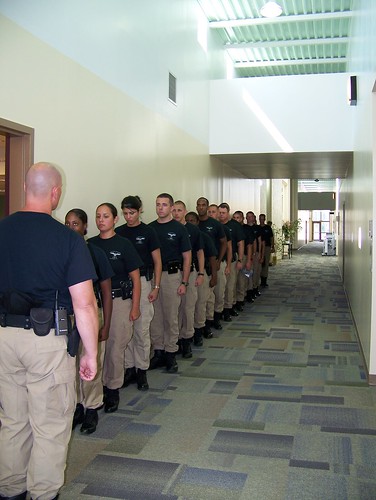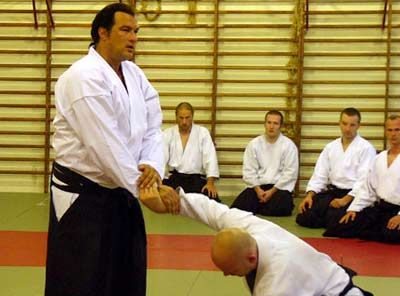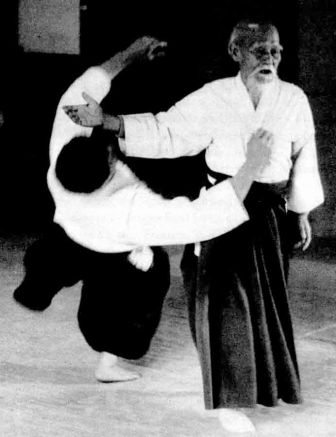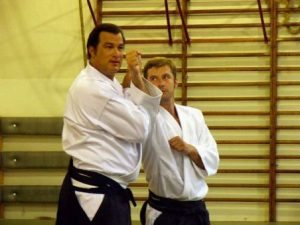Aikido: The Force Behind Use Of Force
Before police officers actually hit the streets to begin making arrests, directing traffic, responding to domestic complaints, and investigating murders, they must attend a basic police academy to receive their certifications as police officers. The time spent at a police academy varies. Some basic classes last for as little as twelve weeks while others may last in excess of five or six months. Police academy training is quite similar to military basic training.

Some academies require police officer recruits to live on-site during their training, such as the Virginia State Police Academy pictured above. The VSP academy is a full-service operation, complete with dormitories, an indoor pool, and cafeteria facilities.

Police academy training is similar to military basic training
Other locales require their police candidates to attend public police academies, such as those taught in some local community colleges. Officer candidates there must pay for and complete their own training before they can apply for a job with the prospective police agency.
A fantastic example of a college/police academy is the Basic Law Enforcement Training program at Guilford Technical Community College in North Carolina, the home of our own Writers’ Police Academy. Sheriffs and police chiefs often scout the college police certification programs looking for top candidates. If one of the recruits stands out (high academic and practical achievements) the officials may offer a job to that particular officer-to-be. Such is the case of my nephew who has a job as a deputy sheriff waiting for him after he graduates from the police academy this weekend (Congratulations, Nephew! WEAR YOUR VEST!)
Basic training consists of many aspects of law-enforcement, but perhaps the most memorable course is—the one course that sticks in the minds of all police officers—Defensive Tactics. Recruits often refer to this week in the academy as Hell Week.
During Hell Week recruits learn how to defend themselves from weapon wielding attackers, and they learn various techniques, such as weapon retention, weapon disarming, handcuffing, baton use, Taser and stun gun use, how to effectively arrest combative and non-combative suspects, and the proper and safe use of pepper spray. They’re also required to exercise and run….lots and lots of exercising and running. And when they’ve finished all that exercising and running, they run and exercise some more. I still have blisters on my feet from the weeks I spent running through the grounds of the VSP academy.
The training is intense, very painful, and exhausting.

Recruits learn to control and handcuff combative suspects by using pain-compliance techniques—wrist-locks and joint control. These techniques are based on the techniques used by martial artists. Aikido and Chin-Na are two of the martial arts used to develop these highly-effective techniques.
Aikido founder Morihei Ueshiba (O-Sensei, “The Great Teacher”).
Aikido (The Art of Peace) uses the attacker’s own force against him.
Sticking to O-Sensei’s original teachings, Yoshinkan Aikido was first taught to the Tokyo Metropolitan Police in the early 60’s. The Tokyo Riot Police receives Yoshinkan Aikido instruction to this day. Aikido techniques in American police academies are a bit less intensive.
To give you a better understanding of Aikido and what the techniques look like in action, think Steven Seagal, a 7th dan black belt in Aikido.
The purpose of police defense tactics training is actually threefold—to protect the officer, make a safe arrest, and protect the attacker/assailant from harm.
Basic Aikido For Law Enforcement
1. Develop a keen sense of awareness. Learn to observe the entire picture. No rear attacks!
2. Being able to quickly move forward, backward, side-to-side, and diagonally… all without losing your balance.
3. Verbally calm down any potential aggressor.
4. Knowing the right time to arrest or detain a suspect. Avoid any escalation of violent behavior.
5. Having the tools to cause pain without causing injury—use of pressure points to safely effect the arrest.
6. Always use the minimum amount of force necessary to make the arrest.
Remember:
– Unbalancing the suspect is key to reducing their resistance.
– Control the head and the body will follow.
– Move the suspect into a position where their chance of reaching you with an attack is greatly reduced—controlling their arms, wrists, elbows or shoulders.
A wrist turnout applies intense pressure to the joint in the wrist, forcing the suspect off balance.
Proper grasp to begin the wrist turnout (Kotegaeshi Nage) technique. To complete the technique the officer maintains his grasp, rotates the suspect’s hand up and to the rear in a counter-clockwise motion while simultaneously stepping back with his (the officer) left leg. The suspect ends up on the floor on his back (see picture below). Any resistance inflicts excruciating pain in the joints of the wrist, elbow, and shoulder.
Combative suspects are normally forced the ground for handcuffing. From this position, a quick turn of the suspect’s wrist and arm will force him to roll over on his stomach. Any resistance causes extreme pain and could severely injure the controlled wrist, elbow, and shoulder.
To effectively control the wrist, the elbow must be stationary. From this position, the suspect is easily handcuffed.
This wrist lock can cause intense pain in the wrist, the elbow, and the shoulder. Forward and downward pressure forces the suspect to the ground.
* * *
I was a police academy instructor and instructor trainer for many years, teaching basic, advanced, and in-service classes such as, Defensive Tactics, Officer Survival, CPR, Interview and Interrogation, Homicide Investigation, Drug Recognition, and Firearms. I also trained, certified, and re-certified police academy instructors. Outside the academy, I owned my own school/gym where I taught classes in rape-prevention, personal self-defense and self-defense for women, and advanced training for executive bodyguards. I trained others in stick (tambo) and knife fighting. Throughout my career I maintained the rank of Master Defensive Tactics Intructor/Aikido and Chin-Na.
“To control aggression without inflicting injury is the Art of Peace.” ~ Morihei Ueshiba










The wrist lock, or turnout is a very cool technique. I once had a bad guy threaten to put a cigarette out in my eye while I had his partner in that hold. It’s amazing how the shrieks of pain from your buddy will change your attitude Tout de Suite. He lay very nicely on his stomach on the ground with his hands behind his head until my backup arrived.
I love Aikido although I was unable to participate due to all the tumbling – motion sickness. I found that the The Filipino Martial Arts were great for defense against bladed weapons — I think the program “Surviving Edged Weapons” had two Filipino martial artists as part of the program. I believe they were Dan Inosanto and Leo Gaje. Two great masters.
There’s a great scene in my crime fiction novel “The Sparrow’s Blade” where a Russian thug is summarily subdued by an opponent who is highly skilled in the art of Aikido. I like to think that it is accurately written because I had occasion to see several Aikido practicioners in action many years ago when I was a member of my college karate team. Aikido is definitely the most “beautiful looking” of the martial arts.
What great timing on this Lee, I’m about to write a scene where my cop has to take down some drunks. Hopefully I can write the scene well with these techniques in mind.
So, you taught Defense Against the Dark Arts? Cool. Glad to know you outlasted Harry Potter’s DADA profs, all of whom seemed to meet weird ends.
Love the photos of the sensei throwing the student.